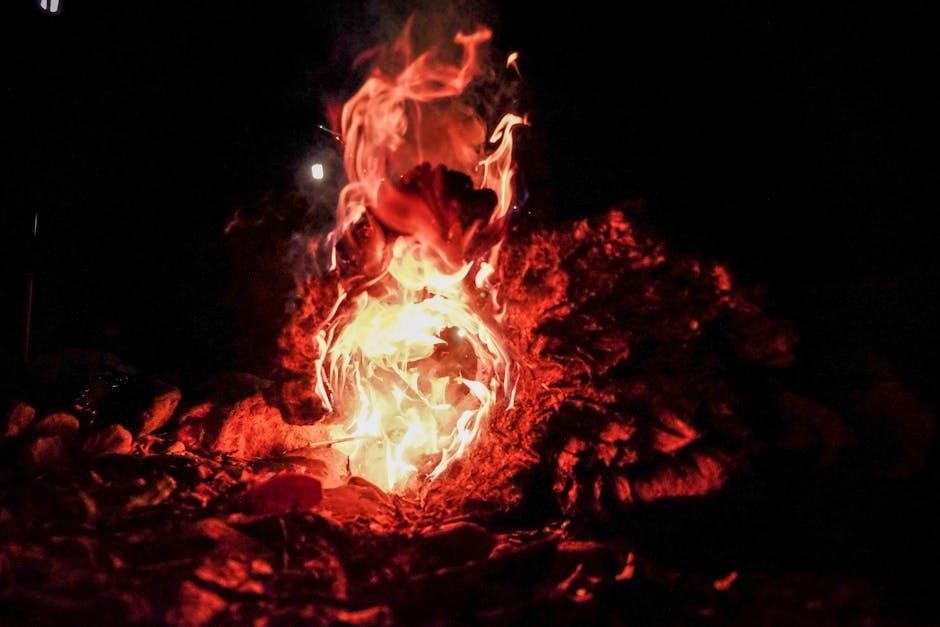htv temperature guide
Discover the ideal temperatures for your heat transfer vinyl projects. Get perfect results every time with our expert guide! Learn more now!
Heat Transfer Vinyl (HTV) is a popular material for custom designs. This guide explores temperature settings, tools, and techniques for optimal HTV applications, ensuring durability and quality.
1.1 What is HTV?
Heat Transfer Vinyl (HTV) is a versatile, thermoplastic material used for creating custom designs on fabrics, plastics, and other surfaces. It consists of a heat-activated adhesive backing and a decorative layer. When heat and pressure are applied, the vinyl adheres to the substrate, allowing for intricate, durable designs. HTV is widely used in crafting, apparel, and signage due to its ease of application and variety of finishes, including glossy, matte, metallic, and holographic. Its popularity stems from its adaptability and the ability to produce professional-quality results with minimal equipment.
1.2 Importance of Temperature in HTV Applications
Temperature is crucial in HTV applications as it determines the success of the transfer process. Proper heat ensures the adhesive melts evenly, adhering vinyl to the substrate without damaging the material. Insufficient heat may result in incomplete adhesion, while excessive heat can cause vinyl discoloration or substrate scorching. The ideal temperature varies based on vinyl type, substrate material, and desired finish. Achieving the right balance ensures long-lasting, professional-quality designs, making temperature control a critical factor in any HTV project.

Understanding HTV Basics

Heat Transfer Vinyl (HTV) is a versatile material used for creating custom designs. It requires heat, pressure, and proper application to transfer vinyl onto fabrics and surfaces effectively.
2.1 Types of Heat Transfer Vinyl
Heat Transfer Vinyl (HTV) comes in various types, each designed for specific applications. Standard vinyl is the most common, offering durability and versatility for everyday use. Glitter, metallic, and holographic HTV add decorative effects, perfect for eye-catching designs. Specialty vinyls like glow-in-the-dark or reflective HTV are ideal for unique projects. Each type has distinct properties, such as thickness, flexibility, and finish, making them suitable for different fabrics and desired outcomes. Understanding the characteristics of each HTV type ensures proper application and long-lasting results. Choosing the right vinyl depends on the project’s requirements and desired visual impact.
2.2 Role of Temperature in HTV Transfer

Temperature plays a critical role in HTV transfer, directly affecting adhesion and durability. Proper heat activates the adhesive backing, ensuring the vinyl bonds securely to the fabric. Insufficient heat may result in weak adhesion, while excessive heat can damage the vinyl or fabric. The ideal temperature varies depending on the vinyl type and fabric, but most standard HTVs require between 280°F to 320°F. Accurate temperature control ensures a professional finish and prevents issues like peeling or discoloration. Monitoring and adjusting heat settings is essential for achieving long-lasting, high-quality results in HTV applications;
2.3 Time and Pressure: Key Factors Alongside Temperature
Time and pressure are equally vital in HTV transfer, complementing temperature for a successful application. The recommended press time typically ranges from 10 to 20 seconds, depending on the vinyl type and fabric. Applying consistent pressure ensures full contact between the vinyl and material, preventing air pockets. Too little pressure can lead to incomplete adhesion, while too much may damage delicate fabrics. Balancing time, temperature, and pressure ensures a flawless transfer, maximizing durability and visual appeal. These factors must be adjusted based on specific HTV types and fabric characteristics for optimal results.

Temperature Settings for Different HTV Types
Standard HTV typically requires 300°F, while glitter and metallic HTV may need higher temperatures, up to 320°F. Adjusting settings ensures proper adhesion and durability for various vinyl types.
3.1 Recommended Temperature for Standard HTV
Standard HTV typically requires a temperature range of 300°F to 320°F (149°C to 160°C) for optimal application. This ensures the adhesive melts properly, bonding the vinyl to the fabric. Lower temperatures may result in incomplete adhesion, while excessive heat can damage the vinyl or fabric. Always pre-press the fabric to remove moisture, which can interfere with the transfer process. Using a heat press with precise temperature control is essential for achieving professional results. Proper temperature settings are critical for durability and longevity of the design.
3.2 Specialized HTV: Glitter, Metallic, and Holographic
Specialized HTV types like glitter, metallic, and holographic require precise temperature adjustments. Glitter HTV typically needs higher temperatures (310°F ― 330°F or 154°C ― 166°C) to ensure the adhesive melts thoroughly. Metallic HTV may require slightly lower temperatures (290°F ― 310°F or 143°C ― 154°C) to prevent damage to the metallic coating. Holographic HTV often falls within the standard range but may need extended pressing time for optimal results. Always test a small area first to avoid scorching or discoloration, especially with metallic and holographic finishes.

Tools and Equipment for HTV Temperature Control
Essential tools include heat presses, temperature guns, and household irons. These devices help maintain precise temperatures, ensuring optimal HTV adhesion and design quality.
4.1 Heat Press Temperature Settings
Heat presses are crucial for achieving precise temperature control in HTV applications. Most HTV materials require temperatures between 270°F and 300°F (130°C to 150°C). Standard vinyl typically needs 280°F (138°C), while specialized types like glitter or metallic may require higher settings. The press should preheat to the recommended temperature before applying the vinyl. Factors like fabric type and vinyl thickness can influence the ideal setting. Always test with a temperature gun to ensure accuracy. Adjusting the heat press settings correctly ensures proper adhesion and prevents damage to the material or substrate. Proper calibration is key for consistent results.
4.2 Household Iron Temperature Guide
Household irons can be used for HTV applications, but precise temperature control is essential. Most irons have settings labeled by fabric type rather than exact temperatures. For HTV, the cotton or linen setting (usually 300°F to 350°F) is recommended. Avoid using steam, as it can interfere with adhesion. Preheat the iron to the desired temperature and test on scrap fabric. If the iron has a temperature dial, adjust it to the appropriate level for the specific HTV material. Always use a heat-resistant surface and apply even pressure to ensure proper transfer and adhesion. This method is ideal for small projects or crafting without a heat press.
Advanced Techniques in HTV Temperature Management
Mastering HTV temperature involves layering, fabric-specific adjustments, and material thickness considerations. Precise control ensures vibrant designs and durability, especially for complex or multi-layered projects.
5.1 Layering HTV: Temperature Considerations
Layering HTV requires precise temperature control to ensure each layer adheres properly without damaging underlying materials. Start with a lower temperature for the base layer and gradually increase for subsequent layers. This prevents overheating and ensures vibrant colors. Specialized tools like temperature-sensitive tape can help manage heat distribution. Always pre-press fabric to remove moisture, enhancing adhesion. Cooling time between layers is crucial to prevent vinyl from melting or peeling. Adjustments may vary based on vinyl type and fabric thickness, making it essential to test settings on scrap material before final application. Proper layering techniques ensure long-lasting, professional-looking designs.
5.2 Adjusting Temperature for Different Fabric Types
Fabric type significantly impacts HTV temperature settings. Cotton and cotton-poly blends typically require medium heat, while delicate fabrics like silk or polyester need lower temperatures to prevent scorching. Thicker materials, such as canvas or denim, may require higher heat for proper adhesion. Adjustments should also consider fabric thickness and sensitivity. Using a press cloth or parchment paper can protect fragile fabrics. Test pressing on scrap fabric ensures optimal results without damaging the final product. Proper temperature adjustment enhances durability and prevents damage, making it crucial for achieving professional-quality designs across various fabrics. Always consult fabric-specific guidelines for best outcomes.

Troubleshooting Common HTV Temperature Issues

Common HTV temperature issues include poor adhesion or scorching. Adjusting heat settings and using a press cloth can often resolve these problems effectively and quickly.
6.1 Fixing HTV That Doesn’t Adhere Properly
If your HTV isn’t adhering properly, check the temperature and pressure. Increase the heat slightly, ensure even pressure, and extend press time. Clean the fabric surface beforehand to remove oils or residues. Using a heat-resistant cloth can also help prevent moisture interference. Re-press the design following these adjustments for better adhesion. Always refer to the manufacturer’s guidelines for specific HTV types, as some may require higher temperatures or longer application times. Proper surface preparation is key to achieving a lasting bond.
6.2 Preventing Scorching or Discoloration
To prevent scorching or discoloration, ensure the temperature is appropriate for the specific HTV type. Use a thermometer to verify heat press accuracy. Apply a heat-resistant cloth or parchment paper to protect the fabric. Avoid overheating by reducing press time if necessary. Test settings on scrap fabric first to gauge results. Proper pressure distribution is also crucial, as uneven heat can cause damage. Store HTV in a cool, dry place to maintain its quality and prevent premature degradation. Always follow the manufacturer’s temperature and time guidelines for optimal results.
Safety and Best Practices
Always wear protective gloves and goggles when handling heat presses. Ensure proper ventilation to avoid inhaling fumes. Keep children and pets away from the workspace. Regularly maintain your heat press to ensure consistent temperature and pressure for safe, high-quality results.
7.1 Safety Precautions When Working with Heat

When working with heat transfer vinyl, always prioritize safety. Wear heat-resistant gloves and protective eyewear to prevent burns and injuries. Ensure your workspace is well-ventilated to avoid inhaling fumes from the vinyl or heat press. Keep flammable materials, such as fabric scraps or paper, away from the heat source. Avoid wearing loose clothing that could catch fire. Never leave a heat press unattended while it is in use. Keep a fire extinguisher nearby and have a first-aid kit on hand. Regularly inspect your heat press for damage to prevent accidental burns or electrical hazards.
7.2 Maintaining Optimal HTV Performance
To ensure optimal HTV performance, store the vinyl in a cool, dry place away from direct sunlight. Use a heat press with accurate temperature control to prevent overheating. Regularly clean the heat press surface to avoid residue buildup. Allow the vinyl to cool slightly before handling to prevent stretching or damage. Always follow the manufacturer’s instructions for temperature and time settings. Avoid applying HTV to damp or uneven surfaces, as this can hinder adhesion. For consistent results, test a small sample before applying to your final project. Proper care and adherence to guidelines will extend the life and quality of your HTV designs.

